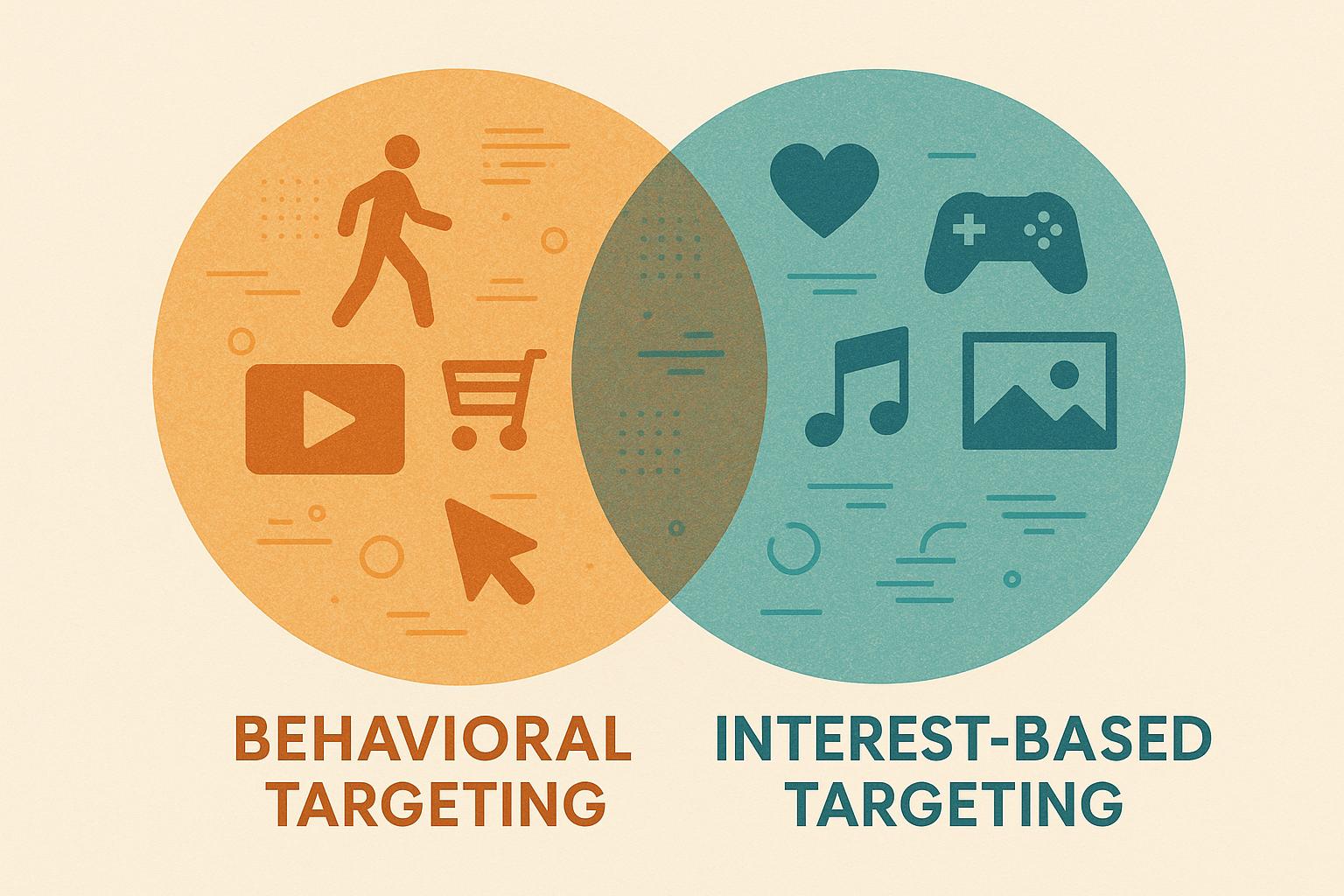


Explore the differences between behavioral and interest-based targeting in digital advertising and how they can be effectively combined for better results.
Behavioral and interest-based targeting are two key strategies in digital advertising to deliver personalized ads to the right audiences. Here's the difference:
- Behavioral targeting focuses on users' online actions, such as browsing history, purchases, and clicks, to predict future behavior.
- Interest-based targeting groups users based on their hobbies and passions, analyzing the content they engage with to understand their preferences.
Both methods aim to improve ad relevance, but they differ in data collection, personalization level, and privacy implications. Behavioral targeting is ideal for precise, action-driven campaigns, while interest-based targeting works better for broader, passion-driven outreach.
Quick Comparison
| Feature | Behavioral Targeting | Interest-Based Targeting |
|---|---|---|
| Data Source | User actions (browsing, purchases) | Content engagement (articles, videos) |
| Personalization Level | Highly specific | Broadly tailored |
| Privacy Concerns | Higher due to detailed tracking | Lower, relies on broader data |
| Best For | Repeat purchases, personalized ads | Reaching new audiences, brand awareness |
For campaigns targeting developers, combining both strategies often yields the best results. Start with interest-based targeting to build trust and relevance, then layer in behavioral data for personalized recommendations. This hybrid approach respects privacy while delivering impactful results.
What is Interest vs. Behavior Targeting on Facebook (EXPLAINED)
How Behavioral Targeting Works
Behavioral targeting works like a digital sleuth, tracking user activity to build detailed profiles that enable personalized advertising. Unlike basic demographic targeting, this approach focuses on actual user actions - like browsing habits, clicks, and purchases - to predict what someone might want to see or buy next. It’s a cornerstone of modern advertising strategies and plays a pivotal role in delivering tailored experiences.
The Mechanics of Behavioral Targeting
The process starts with gathering data from various online interactions. This data is then grouped into segments based on shared behaviors and purchasing intent. Advanced algorithms analyze these patterns, allowing advertisers to deliver ads in real-time that align with users' interests.
"Behavioral targeting means taking the entirety of customer behavior, and personalizing communication based on that." - Jon Palmer, Lead Product Marketing Manager at Klaviyo
Benefits of Behavioral Targeting
Behavioral targeting offers several advantages by leveraging precise data analysis. For starters, it creates highly personalized experiences. Unlike demographic targeting, this method hones in on what people actually do online. Research shows that 91% of consumers are more likely to make a purchase when brands personalize their communications, and 43% say personalized ads play a role in their buying decisions.
Another major benefit is an improved return on investment (ROI). Take U.S. Polo Assn., for example. By combining behavioral targeting with predictive analytics, they saw a 311% jump in conversion rates, a 135% increase in return on ad spend, and a 58% drop in customer acquisition costs. Similarly, Pierre Cardin achieved a 67.96% reduction in cost per acquisition and a staggering 445% rise in conversion rates by creating detailed behavioral segments for their campaigns.
Additionally, behavioral targeting supports continuous optimization. By monitoring and analyzing user interactions over time, advertisers can fine-tune their strategies on the fly. This feedback loop ensures that campaigns become increasingly effective, delivering content that resonates more deeply with users.
Drawbacks of Behavioral Targeting
Despite its benefits, behavioral targeting comes with challenges, and privacy concerns top the list. Many consumers are uneasy about how their data is used. In fact, only about half of people trust brands to safeguard their personal information, and 81% of respondents in a global survey said it’s unethical to use their data for personalized ads without explicit consent.
Regulatory compliance is another hurdle. Laws like GDPR and CCPA impose strict rules on how data is collected, stored, and used. The gradual elimination of third-party cookies has made data collection even trickier, pushing advertisers to rethink how they track user behavior while adhering to privacy regulations.
Behavioral targeting also faces accuracy and bias issues. Algorithms aren’t foolproof, and ads can sometimes miss the mark due to inaccurate data. There’s also the risk of reinforcing stereotypes through biased targeting, which can harm a brand’s reputation.
"Behavioral data does have some limitations. It can't always tell you how a consumer feels. What do you do when your target isn't defined by a behavior, but rather by how they think or what they believe?" - Kasha Cacy, CMO of Known
Finally, the cost and complexity of implementing behavioral targeting can be a barrier, especially for smaller businesses. Building the systems needed to collect and analyze behavioral data often requires significant investment and technical expertise. These challenges set behavioral targeting apart from simpler interest-based methods, paving the way for a closer comparison.
How Interest-Based Targeting Works
Interest-based targeting zeroes in on what people care about most. By focusing on hobbies, passions, and preferences, it creates campaigns that connect with audiences on a more personal level.
The Mechanics of Interest-Based Targeting
This approach works by grouping users based on their online behaviors - things like websites they visit, social media activity, search habits, and how they interact with apps and content. For example, actions such as liking pages, watching videos, joining groups, browsing products, or attending events are tracked to build detailed profiles . Advanced algorithms then organize these behaviors into specific interest categories.
Major platforms like Facebook and Instagram offer powerful tools for interest-based advertising, while Google Ads provides sophisticated audience segmentation options. Data management platforms (DMPs) and Customer Data Platforms (CDPs) further refine these strategies by organizing and analyzing interest data. The information comes from various sources, including:
- First-party data: Collected directly from customer interactions.
- Second-party data: Shared through partnerships.
- Third-party data: Purchased from aggregators or data marketplaces.
These combined data sources create dynamic profiles that fuel campaigns designed to spark meaningful connections.
"Interest Targeting is a digital marketing strategy employed to reach potential audiences based on their interests, behaviors, and preferences." - pangea.app
Benefits of Interest-Based Targeting
Building campaigns around user interests leads to more engaging and personalized experiences. This method thrives by adapting to changing preferences, ensuring campaigns remain relevant.
The results speak for themselves. Studies reveal that 71% of customers expect content tailored to their needs and interests, and 76% feel frustrated when it’s not. By aligning ads with individual interests, businesses can significantly boost engagement.
"Interest targeting ensures that the ads users see align with their personal interests, increasing the likelihood of engagement." - SimpleTiger LLC
Another advantage is efficiency. By dividing audiences into specific interest groups and crafting content for each, advertisers can reduce wasted ad spend. This approach focuses resources on users most likely to respond. It’s particularly effective for reaching broader audiences united by shared passions, whether personal or professional.
Drawbacks of Interest-Based Targeting
While interest-based targeting offers many benefits, it’s not without its challenges. One key issue is accuracy. The success of this approach depends on having current and precise data. Outdated or incorrect information can lead to campaigns targeting the wrong audience.
This method also risks overlooking emerging customer segments or individuals whose interests are still evolving. Users who browse privately or engage less frequently may not be accurately represented in interest profiles. Additionally, it can be tricky to distinguish between different levels of interest. For instance, someone engaging with photography content might be a professional, a hobbyist, or just a casual viewer, and the system may not capture these distinctions.
Platform-specific factors also play a role. The effectiveness of interest-based targeting can vary depending on the platform, and changes to algorithms or data policies can disrupt campaign performance. Lastly, managing a wide range of interest categories without over-segmenting can be complicated. Advertisers must strike a balance between precise targeting and reaching a broad enough audience for effective results.
Behavioral vs Interest-Based Targeting: Side-by-Side Comparison
Now that we've covered the basics, let’s dive into the key differences between behavioral and interest-based targeting. Both approaches aim to connect with the right audiences, but they differ in how they gather data and deliver results.
Main Differences Between Both Methods
At the heart of it, the distinction lies in what each method tracks. Behavioral targeting zeroes in on user actions - like browsing history, past purchases, and clicks - while interest-based targeting focuses on what users are currently engaging with, such as articles, videos, or social media content.
| Feature | Behavioral Targeting | Interest-Based Targeting |
|---|---|---|
| Data Source | User actions (browsing, purchases, clicks) | Content engagement (articles, videos, social media) |
| Data Collection | Cookies, web beacons, tracking pixels | Demographic and psychographic data paired with content signals |
| Personalization Level | Highly specific to individual behaviors | Tailored to users' current interests |
| Privacy Implications | Faces stricter privacy and consent rules | Less reliant on direct data collection |
| Ad Placement Flexibility | Works across various websites | Limited to contextually relevant placements |
| User Experience | Reflects past behaviors for relevance | Complements the content users are consuming |
These differences help determine which method suits your campaign goals best.
When to Use Each Targeting Method
The right approach depends on your campaign's objectives and the data you have at hand. Interest-based targeting works well when you need to focus on immediate relevance, especially in situations where privacy concerns limit data collection or when reaching new audiences is a priority. As Leah Lipka, Campaign Analyst at Pathlabs, explains:
"Contextual marketing is about getting ads in front of people who have already identified interest in a topic, utilizing inventory that is a natural fit for the ad content."
On the flip side, behavioral targeting is ideal when you have access to rich historical data and want to drive repeat purchases or serve personalized recommendations.
For campaigns targeting developers - like those on daily.dev Ads - interest-based targeting often performs better. Developers value privacy and prefer ads that align with their immediate focus rather than ads based on past activity. For example, promoting developer tools or events within relevant programming content leads to more natural engagement. A good starting point is to use interest-based targeting to attract new audiences, then transition to behavioral targeting once you’ve achieved at least 200 monthly conversions.
Using Both Strategies Together
Combining these two approaches can take your campaign to the next level. By integrating Custom and Core Audiences or refining Lookalike Audiences, you can create highly specific campaigns.
The numbers back this up: 76% of consumers are more likely to buy from brands that personalize their marketing, and 95% of advertisers using contextual advertising expect revenue growth. For example, a tech platform could use behavioral data to understand developers' past preferences while layering it with content cues to target those exploring new programming frameworks. This dual approach narrows the audience while keeping the reach broad enough to be effective.
As Samantha Allison, director at StackAdapt, puts it:
"With contextual, ads are targeted based on the content the audience is consuming in the present moment, ensuring they're captured in the right frame of mind to be receptive to the ads."
This hybrid strategy is becoming crucial as digital advertising evolves. Over 60% of advertisers plan to increase their contextual ad spend, highlighting the importance of balancing personalization with privacy. To make the most of this approach, continually test and tweak your campaigns based on factors like location, budget, and seasonal trends. Together, these strategies can help create impactful advertising campaigns that resonate, particularly in developer-focused ecosystems.
sbb-itb-e54ba74
Targeting Developers Effectively
Reaching developers is no small feat. Their unique mindset and preferences often make traditional advertising approaches ineffective.
Key Factors for Developer Targeting
To connect with developers, you need to understand their pragmatic, often skeptical nature. Factors such as their technology stack, job role, work context, and seniority play a huge role in shaping their needs. For instance, a senior JavaScript developer has vastly different priorities compared to a junior Python developer. Interestingly, developers tend to show strong engagement early on, followed by a lull until around the 10–12 month mark. As Anna Eliav Pasquale insightfully puts it:
"Developers engage on their terms, and traditional B2B tactics often miss that nuance."
- Anna Eliav Pasquale, Human. Mama. Digital Storyteller
Technical barriers also complicate targeting. Ad blockers can reduce reach, and developers are cautious about sharing personal data, doing so only after trust is established. They tend to reject pushy advertising tactics, such as intrusive pop-ups, and instead gravitate toward campaigns that highlight technical details and offer clear, tangible benefits.
This nuanced understanding is the foundation of how daily.dev Ads approaches developer targeting.
How daily.dev Ads Reaches Developers

daily.dev Ads combines behavioral and interest-based targeting to engage over 1 million developers worldwide. By focusing on seniority, programming languages, and tools, the platform ensures advertisers can connect with the right audience segments.
The interest-based approach integrates seamlessly into a developer’s daily content consumption. Ads appear in native placements like in-feed content, post pages, and personalized digests, blending naturally into the developer-centric environment. This strategy aligns with the idea of making ads feel less like ads and more like part of the content. On the other hand, behavioral targeting tracks developer-specific engagement patterns, such as interactions with programming languages or tools, to create profiles that reflect their actual project needs.
This dual approach respects developers' demand for relevance and authenticity. Developers often rely on peer recommendations, and daily.dev taps into that trust by ensuring its ads align with developer interests. Additionally, real-time performance tracking allows advertisers to fine-tune campaigns using metrics tailored to developer behavior, rather than relying on generic B2B indicators.
Privacy and Trust in Developer Advertising
Privacy and trust are non-negotiable when it comes to advertising to developers. These audiences expect content to be relevant, useful, and respectful of their boundaries. daily.dev prioritizes these principles by focusing on contextual signals and engagement patterns, rather than intrusive data collection.
This trust-first strategy delivers measurable results. For example, while the industry-standard email opt-out rate hovers around 2.0%, developer-focused campaigns can achieve a much lower rate - just 0.2% on average. Additionally, daily.dev provides expert guidance to help advertisers create messages that resonate. By focusing on real-world demonstrations, addressing specific pain points, and using straightforward technical language, advertisers can build credibility and connection.
The result? An advertising ecosystem that developers trust and engage with, leading to better outcomes for both advertisers and their audiences.
Conclusion
Behavioral and interest-based targeting each bring unique strengths to the table when it comes to reaching developer audiences. Combining these approaches often yields the best results, creating a balance between personalization and broader reach.
Behavioral targeting focuses on user actions like browsing history or purchase behavior, delivering highly tailored ads that can significantly improve conversion rates and ROI. However, it faces challenges with stricter privacy regulations and the diminishing use of third-party cookies.
On the other hand, interest-based targeting aligns ads with users' professional interests, making it a great tool for increasing brand awareness and connecting with niche groups like developers. While it may not offer the same level of personalization as behavioral targeting, it raises fewer privacy concerns by relying on non-personal data.
For developer-focused campaigns, daily.dev Ads demonstrates the power of combining these strategies. By targeting developers based on content engagement, programming language preferences, and seniority, it creates a seamless and effective way to engage this audience within a trusted environment.
Privacy and trust are especially important when dealing with developers, who often have heightened awareness of data usage. Advertisers must carefully balance personalization with respect for user privacy. This makes a hybrid approach even more practical, enabling marketers to deliver impactful campaigns without crossing boundaries.
Ultimately, the choice between behavioral, interest-based, or hybrid targeting should depend on your campaign objectives, available data, and privacy considerations. For platforms like daily.dev Ads, blending both methods ensures developers receive ads that are not only relevant but also respectful of their privacy.
FAQs
How can businesses combine behavioral and interest-based targeting to improve ad performance?
To get the most out of ad campaigns, businesses can merge behavioral targeting - which looks at actions like browsing habits or purchase history - with interest-based targeting, focusing on users' long-term preferences and hobbies. This combination allows for creating campaigns that feel highly personalized, addressing the audience's specific needs and interests.
Take this example: a platform aimed at developers might analyze behavioral data, such as recent searches for programming tools, and pair it with interest categories like preferred coding languages or frameworks. By using this two-pronged strategy, ads become more relevant and timely, boosting engagement and delivering a better return on investment (ROI) by connecting with the right audience at just the right time.
What privacy concerns come with behavioral targeting, and how can businesses address them?
Privacy Concerns with Behavioral Targeting
Behavioral targeting brings up some serious privacy issues, especially when it comes to collecting and using personal data without clear user consent. This lack of transparency can leave users in the dark about how their information is being handled. Even more concerning, sensitive details - like health conditions or personal habits - might be inferred and misused without the individual ever being aware.
To tackle these challenges, businesses need to follow data privacy laws, be upfront about how they collect and use data, and give users straightforward options to opt out of tracking. Providing clear, accessible privacy policies and tools for managing preferences not only builds trust but also ensures that data is handled responsibly and ethically.
Why is interest-based targeting better for reaching new audiences compared to behavioral targeting?
Interest-based targeting works wonders for connecting with new audiences. Instead of relying on past behaviors, it zeroes in on users' stated interests - things like hobbies, favorite topics, and personal preferences. This makes it an ideal strategy for reaching people who haven’t interacted with your brand before but are likely to be drawn to what you offer.
By focusing on specific interests, businesses can serve ads that feel relevant and personalized. This not only grabs attention but also boosts engagement. It’s a smart way to expand your reach, stepping beyond your existing customer base to tap into entirely new groups of potential customers.






